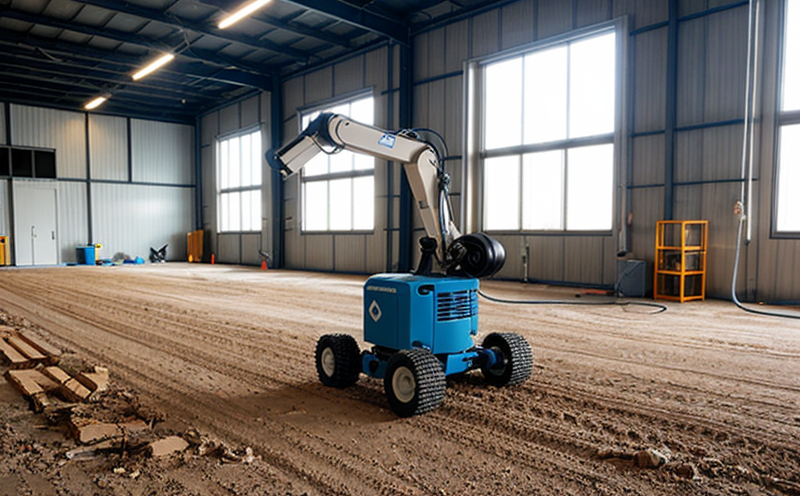ISO 9227 Salt Spray Corrosion Resistance Testing for Robots
The ISO 9227 salt spray corrosion resistance test is a critical procedure used to evaluate the durability of materials and coatings in harsh environments. This testing method simulates the corrosive effects of salt spray, which can be particularly challenging for robotics systems exposed to coastal or industrial environments.
Robots operating in these conditions must withstand environmental factors that can lead to accelerated corrosion. The ISO 9227 test helps manufacturers ensure their robotic components are robust enough to perform reliably over the expected lifespan. This testing is essential for sectors like maritime, automotive, and manufacturing, where robots play a pivotal role.
The procedure involves placing specimens in a specially designed chamber that simulates conditions of salt spray exposure. The test parameters include temperature control, humidity levels, and duration which are crucial to accurately simulate real-world scenarios. By subjecting the robot components to these controlled environments, engineers can identify potential weaknesses and improve design for better corrosion resistance.
The testing process is rigorous and requires precise calibration to ensure accurate results. This includes ensuring that the salt solution composition aligns with ISO 9227 standards, maintaining consistent temperature and humidity levels within the chamber, and adhering strictly to the duration of exposure. The outcomes are critical for quality managers in robotics manufacturing as they help assess the reliability of robotic components under expected environmental stress.
For R&D engineers, this test provides invaluable insights into material selection and coating effectiveness. By understanding which materials and coatings perform best under simulated salt spray conditions, engineers can innovate and develop more resilient robot designs. This is particularly important for industries where robots are used in corrosive environments such as offshore oil rigs or chemical plants.
Compliance officers benefit from the ISO 9227 test by ensuring that all robotic components meet industry standards. The results of this testing can be part of a company's compliance portfolio, demonstrating adherence to international quality and safety regulations. This helps in maintaining market credibility and avoiding potential legal issues related to product failure.
Scope and Methodology
| Parameter | Description |
|---|---|
| Test Specimens | Components of the robot that are expected to be exposed to corrosive environments. |
| Chamber Environment | A controlled environment chamber simulating salt spray conditions with temperature, humidity, and duration parameters set according to ISO 9227 guidelines. |
| Testing Duration | The length of exposure time required to accurately simulate real-world salt spray effects on the materials or coatings being tested. |
| Solution Composition | A precise mixture of salt and water according to ISO 9227 standards, ensuring consistency in testing conditions. |
| Monitoring Equipment | Instruments for monitoring temperature, humidity levels, and the progress of the test within the chamber. |
The testing methodology involves placing the robot components inside a controlled salt spray chamber. The environment is meticulously set to replicate real-world conditions, including specific humidity levels, temperatures, and exposure times. This allows for accurate simulation of corrosive environments that robots might encounter in their operational settings.
During the test, monitoring equipment continuously tracks parameters such as temperature and humidity within the chamber. These readings are critical for ensuring the integrity of the testing process. Once the predetermined duration is met, the specimens are removed from the chamber to evaluate any signs of corrosion or degradation. The results provide valuable insights into how well the materials or coatings withstand corrosive conditions.
The test results are detailed in a comprehensive report that includes all parameters and outcomes. This documentation serves as a critical reference for quality managers, R&D engineers, and compliance officers. It ensures that all stakeholders have access to accurate information regarding the durability of robotic components under expected environmental stress.
Why Choose This Test
- Enhanced Reliability: Ensures robot components are robust enough to withstand harsh environments, leading to improved overall performance and reliability.
- Compliance Verification: Helps manufacturers meet international quality standards, enhancing market credibility and compliance with regulations.
- Innovation Support: Provides valuable data for R&D engineers to innovate and develop more resilient robot designs.
- Risk Management: Identifies potential weaknesses in materials or coatings early in the development process, reducing risks of product failure.
The ISO 9227 salt spray test is an indispensable tool for robotics manufacturers. It offers a clear pathway to achieving the highest standards of quality and reliability. By incorporating this testing into their manufacturing processes, companies can ensure that their robotic systems are not only efficient but also highly durable in challenging environments.
International Acceptance and Recognition
- Adequate Test Coverage: The ISO 9227 test is widely recognized for its comprehensive approach to simulating corrosive conditions, making it a global standard.
- Industry-Wide Adoption: Many leading manufacturers in the robotics sector use this test as part of their quality assurance processes.
The ISO 9227 salt spray corrosion resistance test is internationally accepted and recognized for its ability to provide accurate and consistent results. Its widespread adoption across various industries underscores its reliability and relevance. Compliance with this standard ensures that robotic components meet the highest international standards, thereby enhancing market acceptance and trust.
For companies operating globally, adherence to ISO 9227 not only simplifies compliance but also fosters better relationships with regulatory bodies and potential customers worldwide. This recognition is crucial for maintaining a competitive edge in an increasingly globalized robotics industry.





